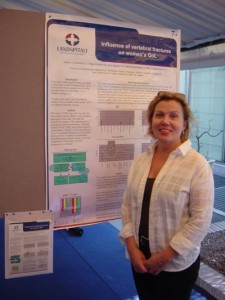Tveir félagsmenn Beinverndar sóttu nýlega aðlþjóðlega fagráðstefnu þar sem þeir kynntu m.a. tvö íslensk rannsóknarverkefni. Ráðstefnan fjallaði eingöngu um áhrif sykurstera á beinabúskap, en alþekkt er að sykursterar sem notaðir er gegn hinum ýmsu bólgusjúkdómum geta valdið ótímabærri beinþynningu. 0.7% fullorðinna Íslendinga nota reglulega sykurstera (Decortin®). Ráðstefna þessi er fimmta alþjóðlega fagráðstefnan um steraorsakaða beinþynningu: GLUCOCORTICOID INDUCED OSTEOPOROSIS – 2007. Actavis studdi félagið v/þessarar vísindaferðar.
Dr Björn Guðbjörnsson, formaður Beinverndar, kynnti tvær rannsóknir sem gerðar hafa verið hér á landi um beinvernd samhliða langtíma notkun sykurstera: Improvement in prevention of corticosteroid induced osteoporosis. Meðhöfundar Björns eru þau Sólveig Pétursdóttir, Unnsteinn Ingi Júlíusson og Friðrik Vagn Guðjónsson (sjá nánar hér fyrir neðan enskan útdrátt).
Þá kynnti Kolbrún Alberstsdóttir MSc, áhrif samfallsbrota á lífsgæði Íslenskra kvenna, en samfallsbrot eru algengustu brotin tengd langtímasykursterameðferð: Influence of vertebral fractures on women’s QoL. Meðhöfundar Kolbrúnar að rannsókn þessari eru: Helga Jónsdóttir, Elvar Birgisson, Halldór Benediktsson og Björn Guðbjörnsson (sjá nánar hér fyrir neðan enskan útdrátt).
Beinvernd þakkar Actavis fyrir stuðninginn vegna fararinnar.
Improvement in prevention of Corticosterioid induced osteoprorosis
Sólveig Pétursdóttir1, Unnsteinn I Júlísusson2, Friðrik Vagn Guðjónsson3, Björn Guðbjörnsson1
Centre for Rheumatology Research1, University Hosital – Reykjavik, Iceland and Health Care Centres in Húsavík2 and Akureyri3, Iceland.
Background: The osteolytic effect of long-term glucosteroid use is well known today. Clinical instructions have been published in most countries, which state how preventive treatment against steroid-induced osteoporosis is to be carried out. The Surgeon General of Iceland provided such instructions on his website in 2001. However, despite the considerable discussion of this problem internationally and the possibilities of good diagnosis and treatment which have been developed in recent years, research in Iceland and in other countries shows that patients on long-term glucosteroid treatment are not receiving satisfactory treatment for bone protection.
Objectives: The objective of this study was to determine the status of bone protection among individuals receiving long-term glucosteroid treatment in Iceland and, in addition, to see if there had been any changes since 1995-96 when a similar study was carried out in the same area of the country that the present study covered. If changes were found, the intent was to assess the situation to see if conditions were acceptable or whether it would be necessary to do better, and in that case, what improvements would be necessary.
Material and methods: Individuals who had received the medicine prednisolone dispensed by the pharmacies in Eyjafjardar and Thingeyjar Counties during the period 01/Jan./2002 – 31/Dec./2003 were sent an introductory letter and a questionnaire which they were asked to fill out. Those individuals who did not have a legal residence in these counties were excluded, as were those who declined to participate. The study included those individuals who took prednisolone continuously for 3 months during the research period, as well as those who took prednisolone for a repeated course of treatment which totalled 3 months a year.
Results: A total of 190 individuals (68%) answered the questionnaire, of which 124 fulfilled the requirements set for participation. The average age was 68 (aged 22-90). The most common indications for treatment were rheumatism (51%) and lung diseases (18%). A total of 54 individuals (44%) had a history of broken bones and 23 had suffered a break after beginning the glucosteroid treatment (19%).
A total of 66 participants (53%) had their bone density measured with DEXA. Sixteen had been diagnosed with osteoporosis and 15 with osteopenia. All of those diagnosed with osteoporosis and 66% of those diagnosed with osteopenia were taking medicine for bone protection. Forty-three individuals (average age 64) were taking ³ 7.5 mg of prednisolone a day, and of these 18 were taking bone-protecting medicine (42%), 15 of whom were taking bisphosphonates. Only 5 of the participants of these 43 took medicine for first stage prevention, while others began taking medicine for second and third stage prevention.
Conclusion: The results of this study indicate an awakening of considerable concern on the part of health employees concerning bone protection among patients on long-term glucosteroid treatment. On the other hand, more could be done to assure that all such patients receive first stage preventive treatment as soon as glucosteroid treatment is initiated and all those providing health care are categorically encouraged to see that such treatment is carried out.
Influence of clinical and non-clinical vertebral fractures on QoL in Icelandic women
Kolbrún Albertsdóttir1, Helga Jónsdóttir2, Elvar Birgisson3, Halldór Benediktsson3,
Björn Guðbjörnsson1,2
Centre for Rheumatology Research1, University Hospital – Reykjavik, Iceland, University of Iceland2 and Department of Imaging, Akureyri Hospital3, Iceland.
Introduction: Approximately 400 women in Iceland may annually experience a vertebral fracture (Vfx). Every sixth woman aged 50 years can expect to suffer from Vfx later during her lifetime. Up to a third of Vfx are not diagnosed and therefore often framed as silent fractures. Most fragility fractures, e.g. Vfx, are related to osteoporosis. Vfx fractures have a major impact on quality of life and also increase mortality rates. The aim of this study was to describe the impact of Vfx on health- related quality of life in a cohort of Icelandic women and thus to increase the awareness of healthcare givers of the effects of Vfx on women’s health.
Method: 350 women, 50-80 years old, who came for bone mineral density (BMD) measurement by DEXA at the Osteoporosis Out-patient Clinic, Akureyri Hospital, were invited to participate in this cross-sectional study. The women answered two standardized quality of life questionnaires, a generalized health questionnaire or the “Icelandic Quality of Life” (IQL) and a disease specific questionnaire of European origin or the “Quality of Life Questionnaire of the International Osteoporosis Foundation” (QUALEFFO). In addition, selected data from BMD measurements, spinal x-rays and standardized clinical data were also systematically collected.
Results: The response rate was 83% (n=289) and the mean age was 64 ± 8 years. Sixty-one women were diagnosed with Vfx (21%) when all x-rays were evaluated, but only 28 of these Vfx were clinical fractures, i.e. known to the women; meanwhile 33 (54%) were undiagnosed or so-called “silent” Vfx. Thirty-seven women had two or more Vfx (61%). Two control groups of women without a history of fractures were established, one matched for age and chronic diseases (n=74) and the other group age- matched healthy women (n=36). Women with clinical Vfx were of significantly less height (p<0.05) and they also had a significantly lower BMD compared with the control group (p<0.001). The IQL demonstrated that women with clinical Vfx had a reduced health-related quality of life on three scales: general health (p<0.01), physical health (p<0.05) and well-being (p<0.05). The QUALEFFO also showed a decreased quality of life, principally based on pain (p<0.01) and physical function (domestic work and activity; p<0.05). Women with undiagnosed Vfx, i.e. “silent” Vfx, had an equal reduction in quality of life as women with clinical Vfx, but less back pain.
Discussion and conclusion: The study confirmed results from previous studies that health-related quality of life of women with Vfx is reduced. Furthermore, the present study also showed that a high percentage of Vfx in Iceland are undiagnosed and women with “silent” Vfx also suffer from a reduced quality of life. The latter group has received little attention from the healthcare providers in Iceland. Nurses take care of elderly individuals who frequently have chronic diseases and who also are at increased risk of Vfx due to osteoporosis. It is therefore of importance to know the risk factors for osteoporosis and the consequences of Vfx on women’s quality of life. Thus, nurses have a significant role to play in disease prevention and health education regarding osteoporosis and in that way may decrease the incidence of new Vfx.

